Frequently Asked Questions
Helping enhance your visual independence, when an eye condition makes it hard to see how.
What is Low Vision?
A person is said to have ‘low vision’ if they are still unable to perform visually-based tasks while using their best-corrected vision. (That is, if they are short, long-sighted or have astigmatism (oval-shaped eye or eye surface) and they are using glasses, contact lenses or have had refractive surgery, but still struggle to see perfectly.
Or
A person may have an eye of the size and shape, which does not require a glasses prescription, but due to the presence of an eye disease, they still require magnification aids or better contrast, to see better, to do the things they wish to do.
See our section on Types of Vision Loss and Eye Conditions, to understand more!
‘Low vision’ can be defined in different parts of the world in a slightly different manner. Traditionally it has been described as one being unable to see below the half-way mark on a standard distance visual acuity chart, despite wearing one’s best glasses (if glasses are needed).
Pictures of distance eye charts for visual acuity testing
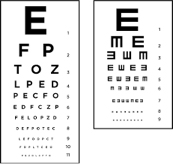
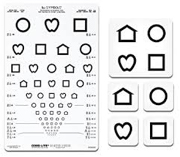
Or
Field loss, making independent mobility or other tasks difficult.
(Here the vision loss is showing what can be experienced in uncontrolled Glaucoma). Should a person require training for independent orientation and mobility, our Orthoptist can refer them on to the appropriate agency or provider.

Do you help anyone in general with challenges, such as: Setting up my reading area comfortably? Lighting advice for the home, school or office? Glare sensitivity? ‘Double vision’? Poor visual development? Or Eye fatigue?
Yes! Orthoptists are trained in visual ergonomics, detecting disorders of eye movement, problems with ‘fusion’ (the brain’s ability to keep two separate images together as ‘one’)
And
Problems with ‘lazy eye’ (amblyopia): where the vision has not fully developed.
Independent ergonomic advice is given or in co-operation with your usual eye doctor’s report, programmes such as patching for lazy eye or convergence and fusion exercises may be given.
Advice can be given on the best sunglasses for those who do see well enough to drive, or just want comfortable, glare-free vision for shopping and walking.
These first photos depict a range of sunglasses available for purchase from Southern Low Vision, alongside the simulation of how an Amber tint can control glare of headlights in passengers or drivers with only mild visual contrast problems, such as from early cataract.
Research has proven these measurable benefits of the Amber tint, do exist for controlling glare from headlights and improving poor contrast vision. However, your eye doctor (Ophthalmologist) or Optometrist needs to ascertain whether your vision is still legally within driving limits, prior to purchasing these. These guidelines can also be generally discussed with our Orthoptist. Other tints available include Grey and Polarised (useful for activities in bright sunlight).
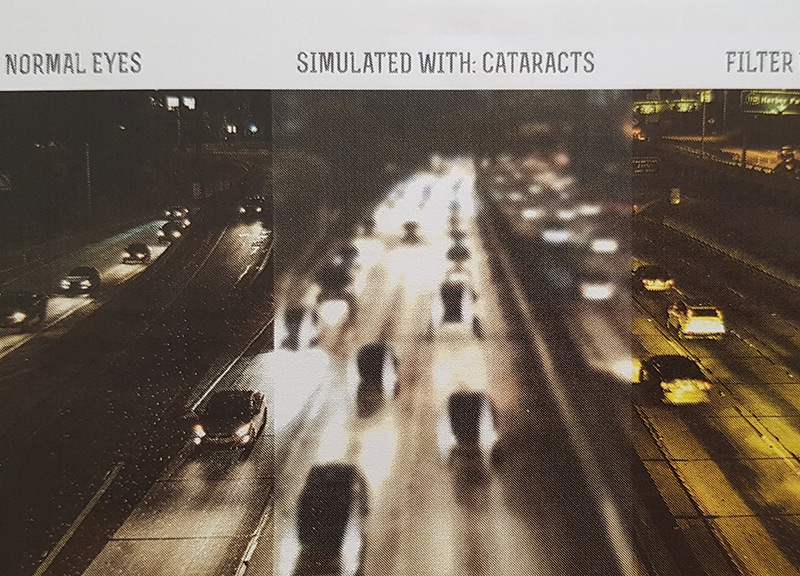
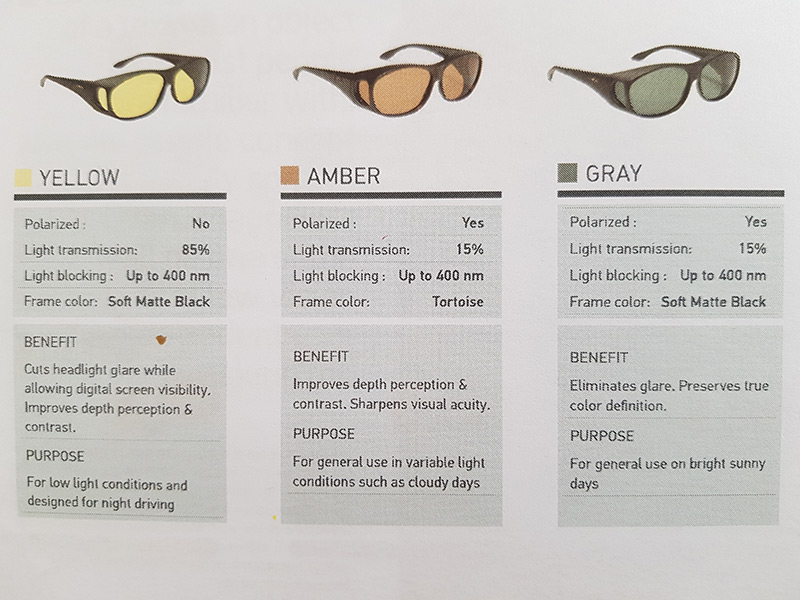
(Photos of night glare and sunglasses courtesy of Humanware)
This second photo is of prism bars; used by our Orthoptist to determine the brain’s ability to fuse images and prevent double vision, e.g. in patients with head injury or visual fatigue. Exercises may be prescribed to patients, improving fusion, to give possible relief from visual fatigue.
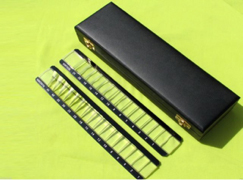
What can you do for students, job-seekers or employees?
A Functional Vision Report is a valuable tool, to help you explain your unique visual status and the way you adapt to it.
This helps teachers, university lecturers, potential employers and your current employer understand that you can still perform tasks, but in a different way. Extra time may be granted in academic arenas, due to the presence of an eye condition and recommendations made in a Functional Vision Report.
What Causes Low Vision?
Vision loss which is un-correctable in the traditional manner, may be brought on by a wide range of reasons. Some conditions are medically based and may affect any part of the eye, which works much like a camera.
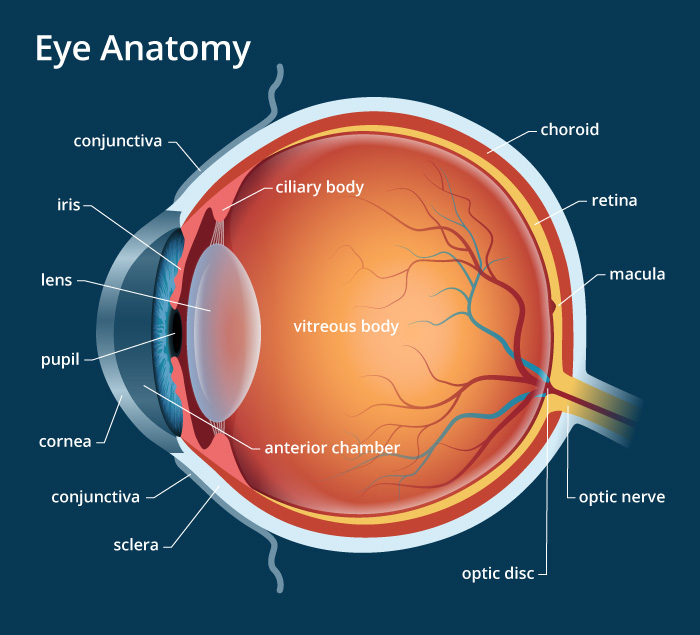
For example:
Macular Degeneration, (in older adults, but also sometimes in children, teens, or younger adults, if genetically linked). An example of macular problems in the younger adult is the genetically inherited condition known as Stargardt’s Disease.
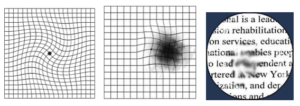
Diabetic Retinopathy, which is a condition present in at least 1.1 million Australian Diabetics, where the blood vessels in the ‘seeing layer’ (retina) are affected.
Problems may include, vessels leaking fluid into the central or other retinal areas, distortion of vision, haemorrhaging within the retina, a blockage in blood supply, ‘patchy’ vision loss, or an increased chance of Glaucoma.
Glaucoma is a condition in which raised pressure within the eye may lead to nerve damage and subsequent peripheral field (side vision) loss.
Whist often managed with drops, surgery or laser, Glaucoma is often asymptomatic (regarded as the ‘sneak thief’ of sight), so annual, two-yearly or sometimes more regular testing by your optometrist or eye doctor is recommended. If you are over the age of 40 or have any family history of eye disease, seek a consultation, regardless of whether symptoms present.
Cataract is the clouding of the lens in the eye, generally due to excessive UV radiation, trauma, or the aging process.
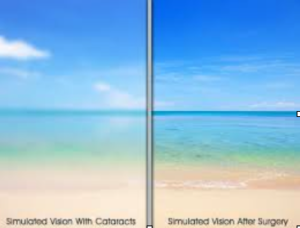
Whilst a cataract is easily removed, by an eye doctor, (with surgery), glare sensitivity or low vision is an issue whilst you wait for your surgery. Some strategies for enhancing contrast, better lighting, magnification and glare control may help you enormously.
Retinitis Pigmentosa, is a genetically linked condition, leading to gradual (and usually complete) vision loss as the peripheral (side) vision ‘closes in’ over several years. Difficulty adapting to the dark is often one of the first signs.

Albinism. This is just one of many general conditions which can have an enormous impact on vision. Due to the reduced amount of pigment in the eye, a person with albinism will generally be more sensitive to bright light. Some low vision is often associated with the condition, however magnification may help.
Nystagmus. Nystagmus is an involuntary ‘jerking’ or ‘wobble’ of the eyes, generally associated with low vision from a young age or sometimes associated with brain-based disorders. In many cases of nystagmus associated with low vision, a person may adopt a head posture to place the eyes in the position of least ‘wobble’.
These sorts of adaptations are best explained to others in a Functional Orthoptic Vision Report, so a strategy can be put in place to help you manage daily life despite this occurring.
Other causes may include any eye condition leading to dysfunction of the visual system or of eye movements and trauma to any part of the eye or brain (so, just like in damage to a wired camera, the image you experience, won’t be perfect).
How is a Low Vision Exam Different from a usual eye test?
Time: An Orthoptic low vision consultation is quite different from a regular eye examination. It is a longer examination usually lasting one hour or more. What is explored includes vision and desired tasks.
Approach: Despite having an eye condition or a functional problem, you will still have goals in life and the low vision rehabilitation approach is to help you achieve these goals using adaptive equipment or new ways to do things.
Our Orthoptist will bring the most appropriate aids to hopefully match your vision, after an initial chat over the telephone.
Outcomes: Your eye condition will remain or will continue to be treated by your usual eye doctor, (ophthalmologist) however, you may see equipment which you never realised existed, to help with the remaining vision you have.
These are the usual outcomes and these will be reported back to your usual eye doctor and/or optometrist.
Talking about your vision loss.
Any professional trained in the challenges of living with low vision will hope to also spend time listening to your concerns.
Specific advice about what will happen next for your condition, is a conversation best had with your eye doctor, however there are numerous support groups specific to certain eye conditions or age-groups. There are also financial packages to help with income, travel and attending social events with family or carers.
We can point you in the right direction for ongoing support, whether it be community social groups, advice about travel if you are unable to drive, or support in changing careers.
How much will my consultation and equipment cost?
For consultation fees and information regarding funding possibilities for eligible individuals, please see our Fees page.
Our Orthoptist, Julie, will perform an initial Low Vision consultation generally taking up to 1 hour. See the pricing for 1st assessment on the Fees page.
This is a service, often performed in your home, workplace or school, or within an office environment in Geelong, if preferred.
*Please bring your latest prescription for distance and near (if glasses are worn)
Will I get new glasses at this assessment? (Glasses don’t help me enough!)
Our Orthoptist, Julie is an allied eye health professional and understands all about your glasses prescription. Her role, however, is to work from this point and provide aids which you will use in addition to your glasses, so Julie works on the premise that your have already explored what the best glasses can do for your eyesight.
New glasses will not be explored or provided, however a wide range of optical or electronic magnification systems and strategies will be explored instead.
Prescribing a low vision aid to match your vision is a skill uniquely performed by Orthoptists in low vision rehabilitation and by just a few specialist optometrists.
The consultation fee is not covered by Medicare, however some levels of private health insurance with Extras such as Eye Therapy, may cover the cost of equipment.
Participants in The National Disability Insurance Scheme, Veterans Affairs Gold Card-holders or Transport Accident Commission clients may also be eligible for funding towards assessment fees and equipment, depending on their needs and level of vision loss.
Our Orthoptist will write to agencies such as the above to help you receive funding for equipment where appropriate.
Pensioner discounts of 10% apply to all private consultations.
Will eye drops be put in my eyes for an examination of inside the eye?
Whilst Orthoptists are trained in exploring disorders of the eye within a clinical environment, a low vision assessment is about exploring aids or strategies for your remaining sight after your usual eye doctor (ophthalmologist) or optometrist has already performed a retinal examination and determined that you need more help.
Low Vision Services complement medical or optometrical eye tests, rather than replace them. We work in a united manner, so you achieve the best level of independence.
How much does low vision equipment cost?
Aids to assist vision will be different for one individual to the next.
They generally may include:
- Sunglasses
- Task lighting
- Large print or talking time-telling devices
- Optical or electronic magnification
- Aids for distance vision.
Low vision devices are therefore very “task specific”. Therefore, prices will vary from as little as $25 for a clock, through to $50-$200 or more for a higher powered illuminated magnifier, with some electronic magnifying devices costing over a few thousand dollars.
Cost-friendly options are always explored by consultation with a range of locally-based providers.
Our Orthoptist also liaises with Adaptive Technology Consultants offering advice about specific Smart Phone Apps, which are ‘low vision-friendly’.
What if my vision changes after I buy a low vision aid?
How Do I Pay For Low Vision Aids?
How many visits are required to solve my problems?
Low Vision rehabilitation does not cure you of your eye disease. This needs constant monitoring by your eye doctor, as some treatment options emerge from time to time.
For magnification: one to two visits may be all that is required, however for Eccentric Viewing, Post-Stroke Reading Rehabilitation, or Orthoptic Exercises, generally anywhere between four to eight sessions are required.
